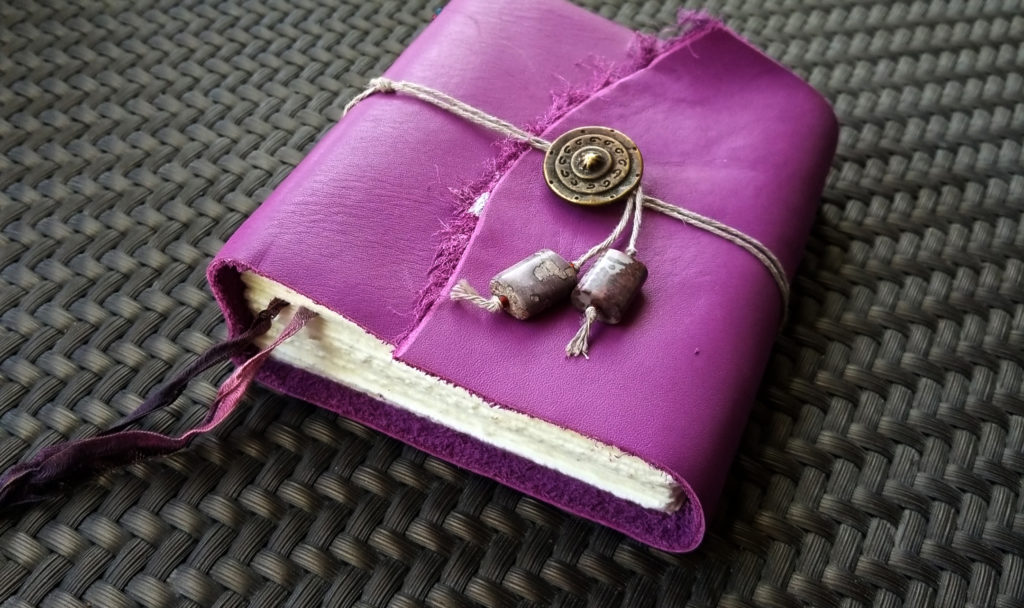A few months back, at a quirky gift shop I discovered on vacation, I spotted my kryptonite: A table covered with handmade, leather-bound journals. No two were identical. I picked up a beautiful purple one and immediately knew I couldn’t resist buying it. Finding a cool journal while traveling felt a little serendipitous, because I stumbled upon my previous favorite journal on another vacation more than 10 years ago. Since I’ve always sucked at journaling regularly, that old one still has some blank pages, but it’s over halfway full of entries from my college and early post-college years. It was definitely time for a fresh start, and it feels good to open a new favorite journal. (And yes: That’s really it in the photo above!)
This got me thinking about all my old journals that I haven’t revisited in ages. So, naturally, I had to dig them out and re-read every single one! For me, that’s the best part about keeping journals: It’s a gift to your future self to be able to open a book and be transported into that younger mindset, or maybe even revisit a specific day you had completely forgotten.
In re-reading these diaries, accumulated over the course of my life, I noticed some interesting patterns in the way I use journals (aside from just, you know, sporadically) that I think will help me improve my journaling habits as I move forward with the new one.
With that in mind, here’s how I’m planning to get into a good journal-keeping groove, based on the lessons I’ve learned from my past journaling “mishaps.” Each of us should find the best process that works for us when it comes to journaling, because our private journals are for no one else’s benefit, after all! (How refreshing??)
Make your first entry about how you acquired/chose the journal
When I was younger, I sometimes hesitated to write in brand new journals because I felt too much “pressure” on starting the very first entry in those blank pages. So, my current strategy is to add the first entry as soon as possible, and simply explain where/why/how I got that specific journal. This is especially great to do if the journal was purchased on a trip, so you can always look back and remember where exactly you were when you found it. I also usually add a few notes about what made me choose that specific journal: the cool binding, the paper, the closure, etc.
Set yourself up to write about whatever is on your mind
Another “mistake” I made with a few journals in the past was that I tried to give them a special purpose—for example, one where I started out with something like, “I’m going to write about my creative ideas and poetry in here.” Neither of those goals was bad, but why make the focus so specific and narrow? It works much better for me to let my primary journal be for whatever I feel like writing about that day, since this A) makes it easy to sit down and write and B) gives the entries more variety and makes the journal more fun to read later on. Looking back, some of my favorite entries from my old journals are the “stream of consciousness” ones, where I start with recent events in my life and lapse into story ideas, and then maybe some random song lyrics, followed by something I’m looking forward to. Journaling is best when the words just flow out of your hand.
That said: I absolutely have secondary journals that have defined purposes! For instance, I was gifted a cute Pusheen journal that I’m trying to use to record random childhood memories when they occur to me. But my primary journal, which I’ll use most often, is the one I grab when I just want to “think on paper.” It doesn’t matter what I write about each time, as long as I’m filling up those pages.
Don’t second-guess what you’re putting in the journal
On that same wavelength, I think one of the reasons I’ve been so inconsistent with journaling is my tendency to overthink what was “journal-worthy” and feel like I was wasting pages if I wrote about mundane things. But when I open my old journals, I always wish I had written more. It’s the blank pages that are wasted, not the filled ones. An empty journal is just waiting to live up to its potential, which is to be full of whatever you want to put in it. Think of it like a treasure chest for your thoughts. Put in as many as you can fit! No one wants an empty treasure chest.
Lots of my old journal entries include thoughts/ideas about my then-current original fiction projects/goals, and re-reading those is so much fun. I remember the stories, but not the full thought processes that went into them, so diving back into that mindset is the best kind of flashback. I wasn’t really thinking about that at the time, though—just writing what was on my mind. But now I know, and I don’t hesitate to include notes about other writing projects while journaling. It makes sense that the act of writing reminds me of writing, of course!
Try to avoid the journal becoming meta
Most of my old journals have late entries where I start out with something like, “Wow, it’s so weird to read all the old stuff I wrote in here!” And while there’s nothing inherently wrong with that, I find that the self-referential journal entries are never as interesting as the ones before that point. Because when I start out with “all that old stuff,” the obvious next step is just to explain how things have changed. But a clearer—and far more natural—way to do that would be if I just wrote out a normal entry about my current life situation instead of a reflective “I can’t believe I wrote blah about X.” When I hit those entries, it feels like the organic, true version of the journal has ceased to exist; it’s become a relic that I’m making notes about. Plus, those entries just emphasize how long I’ve gone without journaling. No more! I’m going to try to change this habit going forward by writing in my journal more consistently and letting each entry flow organically instead of commenting on past entries — and by not re-reading old entries right before I start a new one. (Wish me luck.)
Create a beautiful, comfortable writing space
With my newest journal, I had this lofty idea that I was going to keep it on my antique vanity and sit on the little bench to write by lamplight. So old-fashioned and dramatic!! Well, that didn’t last. For one thing, journaling in front of a mirror is weird. For another, I don’t have a habit of sitting at my vanity for many tasks, which meant I had added another obstacle to starting a journal entry. SO, the obvious solution and much better plan is that the journal lives on my desk, which I recently cleaned and reorganized to be a prettier, more inviting space. All I have to do when I feel like journaling is close my laptop, grab the journal, and flick my lamp on.
Of course, your ideal journaling space might be the complete opposite of mine! In typical introvert fashion, I’m all about a quiet, private room. And dramatic lamp light. But you might want a sunny cafe patio. I also never use my journal except for when I’m unwinding in the evening, but you might want to carry yours with you. The point is, you do you! Just like the content of our journals is specific to each of us, so is the process of journaling. Find your groove. If I’ve given you a list of “tips” that are the total opposite of what you like, let that be your starting point to figure out what’s best for you.
Looking forward, I’m excited about being better at keeping up with my journal. Hopefully I’ll even manage to fill this one up (!!!) before moving on to a new journal.
And someday down the road, I’ll be able to pick up my purple journal, chock-full of my old erratic handwriting, and I’ll rediscover memories that I had forgotten. Like all my old journals, it will be like having a conversation with my past self—only, this time, more comprehensive. But I’m also finding that journaling more frequently is great for me in present-tense, too. It’s relaxing to take a break from typing and just write words on paper. Words that are for no one else but me.

